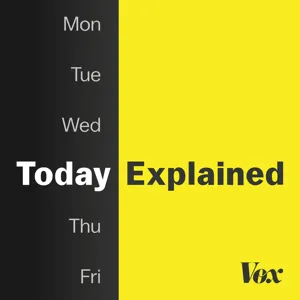Podcast Summary
New EPA rules to limit climate pollution from power plants: The EPA under Biden has announced new rules to limit climate pollution from power plants, targeting coal and gas-fired plants to use advanced technologies like carbon capture from the 2030s onwards, transforming the power sector to meet climate goals.
The Environmental Protection Agency (EPA) under President Biden has announced new rules to drastically limit climate pollution from power plants. These rules apply to coal and gas-fired power plants and set dates from the 2030s for them to start using technologies like carbon capture to reduce greenhouse gas emissions. The power sector, along with transportation, is one of the two biggest contributors to climate pollution in the country. To meet the Biden administration's climate goals, it's necessary to have regulations covering all parts of the economy. The power sector's significant emissions mainly come from coal and natural gas being burned for electricity. The EPA's new regulations aim to transform the power sector by requiring the use of advanced technologies to continue operating while minimizing climate impact. This decade is critical for making decisions to prevent the worst consequences of a climate crisis.
New rules to reduce power sector emissions: New rules could prevent 17M metric tons of CO2 emissions by 2042, equivalent to 137M cars' annual emissions. Power plants can either shut down or install carbon capture tech, but it's expensive and unproven. The Inflation Reduction Act offers incentives to make it more cost-effective.
The new rules aim to reduce greenhouse gas pollution from the power sector by setting limits and targets. These rules could prevent up to 17 million metric tons of CO2 emissions by 2042, equivalent to the annual emissions of 137 million cars. Power plants can either shut down and replace with renewable energy or install carbon capture equipment to store CO2. However, carbon capture technology is expensive and unproven at a commercial scale in the power sector. The Inflation Reduction Act, which includes tax incentives, aims to make carbon capture more cost-effective, setting the stage for its implementation. Despite its importance, utilities have expressed concerns about its affordability. This creates a crucial moment for the power sector to prove the commercial readiness of carbon capture technology.
New EPA regulations limit carbon emissions from US power plants: The EPA is implementing new regulations to reduce carbon emissions from US power plants, but these rules have faced opposition and do not meet the Biden administration's goal of eliminating climate pollution from the power sector by 2035.
The Environmental Protection Agency (EPA) is implementing new regulations to limit carbon dioxide emissions from power plants in the US, following the Clean Air Act passed decades ago. These rules have faced legal challenges in the past and are expected to face more in the future. While Democrats and environmental groups support the rules, Republicans and certain industries have criticized them. The Biden administration aims to eliminate climate pollution from the power sector by 2035, but the new rules do not meet that goal entirely. Additionally, the administration has proposed regulations to reduce emissions in the transportation sector.
Rushing to Implement Climate Change Regulations Before Legal Challenges: The Biden administration is working to reduce carbon emissions and transition to renewable energy before potential legal challenges and elections, driven by economic and global pressures.
The Biden administration is rushing to implement regulations to reduce carbon emissions and transition to renewable energy sources before the end of the term, due to the Congressional Review Act which allows Congress to repeal rules within the first 60 days of a new administration. The economics are in favor of renewable power, but it's not happening fast enough. A new, optimistic development is the potential of carbon capture technology. However, the urgency comes from the global imperative to address climate change and the fact that coal, once the largest source of electricity in the US, now accounts for only about 20%. Mint Mobile offers an affordable alternative for wireless plans, with plans starting at $15 a month for new customers on a 3-month plan. The administration's efforts to implement these regulations face legal challenges and uncertainty about who will win the 2024 elections. The economic and global pressures, however, are driving the push for change.
Regulation of Power Plant Emissions and Clean Hydrogen: The Clean Air Act requires power plants to reduce carbon emissions, and the Inflation Reduction Act offers tax incentives for clean hydrogen production. However, it's crucial to use low-carbon sources for hydrogen production to keep emissions low.
The regulation of power plant emissions, particularly carbon emissions, is a long-standing requirement under the Clean Air Act, as established by the Supreme Court in the Massachusetts v. EPA case in 2007. Power plant operators are required to reduce emissions, and they can do so through various methods, including carbon capture and sequestration or blending hydrogen into natural gas. The Inflation Reduction Act, passed in 2022, includes tax incentives to encourage the production of clean hydrogen, which the Biden administration is investing heavily in. However, there is ongoing debate about what constitutes "clean" hydrogen, as producing it requires significant energy, making it essential to use low-carbon sources such as wind or nuclear power.
The Importance of Producing Clean Hydrogen: The Inflation Reduction Act allocates funds towards producing clean hydrogen, addressing the lack of infrastructure and resources to produce hydrogen from renewable energy sources at a large scale, while tackling challenges like scaling up production and infrastructure development.
The production of clean hydrogen, which is made using renewable energy sources in the same location, is crucial for reducing carbon emissions in industries that are difficult to decarbonize, such as heavy industry and aviation. The term "clean hydrogen" refers to hydrogen produced using clean, new, renewable energy, while "gray hydrogen" is produced using fossil fuels. The U.S. has identified the need to produce clean hydrogen at a large scale due to its potential to significantly decrease greenhouse gas emissions. However, currently, the U.S. lacks the necessary infrastructure and resources to produce clean hydrogen in sufficient quantities. To address this, the Inflation Reduction Act has allocated significant funds towards the production of clean hydrogen. The challenges include scaling up production and creating the necessary infrastructure for hydrogen storage and transportation. Despite these challenges, there is optimism about the potential of hydrogen to bring about significant changes in the country's energy landscape.
Transitioning to clean hydrogen for carbon emissions reduction: Focus on developing flexible electrolyzers and avoiding short-term pollution to make clean hydrogen a viable and efficient solution for reducing carbon emissions.
The transition to clean hydrogen as a solution for reducing carbon emissions is an important step towards addressing climate change, but it requires careful consideration and planning. The hydrogen industry must avoid causing pollution in the short term to maintain public acceptance and branding. Additionally, the industry needs to focus on developing flexible electrolyzers that can store excess renewable energy and turn off during energy surpluses. These technologies will be crucial for making clean hydrogen a viable and efficient solution. While the transition may not happen overnight, optimism is warranted as many of the necessary technologies for addressing climate change are already available. The first steps include cleaning up the electricity sector and electrifying as many aspects of our lives as possible. By focusing on these areas, we can make significant progress towards a future with cleaner energy and reduced carbon emissions.
The Role of Clean Hydrogen in Tackling the Last Quarter of the Climate Crisis: Clean hydrogen is poised to significantly contribute to decarbonizing heavy industries, aviation, and agriculture with the recent tax credit expected to accelerate innovation and deployment, making a substantial impact on hydrogen electrolyzers within the next five years.
While we've made significant strides in addressing three quarters of the climate crisis through clean electricity and electrification, the last quarter remains a challenge. This is where clean hydrogen comes in, set to play a crucial role in decarbonizing heavy industries, aviation, and parts of agriculture. The recent tax credit for hydrogen is expected to spur innovation and deployment, making a substantial impact on hydrogen electrolyzers within the next five years. Overall, the future looks promising for hydrogen's role in tackling the remaining portion of the climate crisis. Additionally, a side note from the podcast episode: Fundrise, an investment platform, plans to expand its real estate portfolio despite the current market challenges. Interested investors can consider adding the Fundrise flagship fund to their portfolios, with a minimum investment of $10, by visiting fundrise.com/fox. As always, it's essential to carefully consider the investment objectives, risks, charges, and expenses before investing. This is a paid advertisement.



